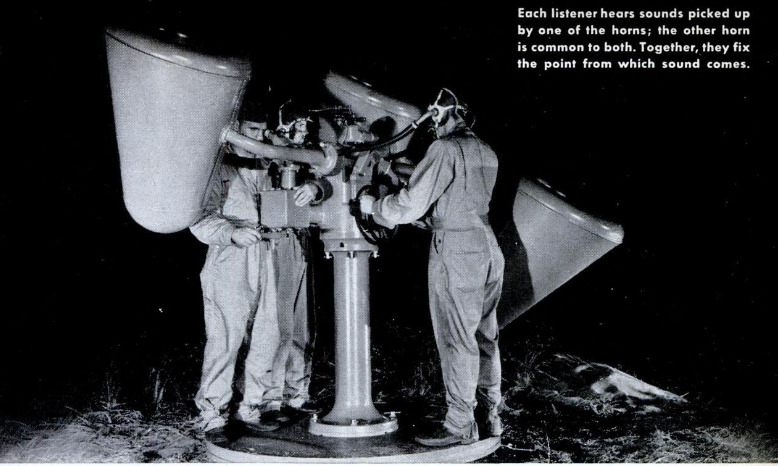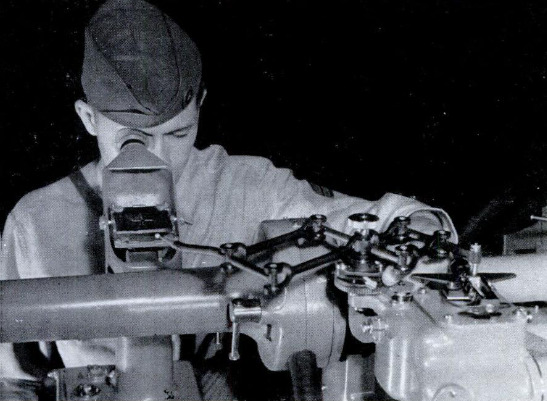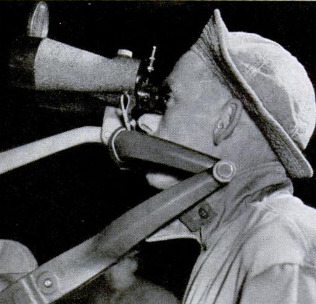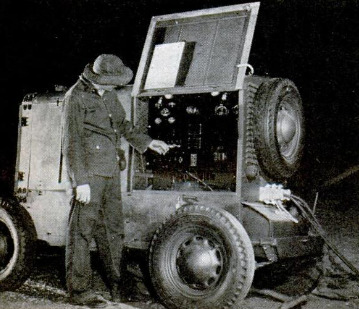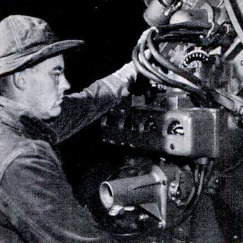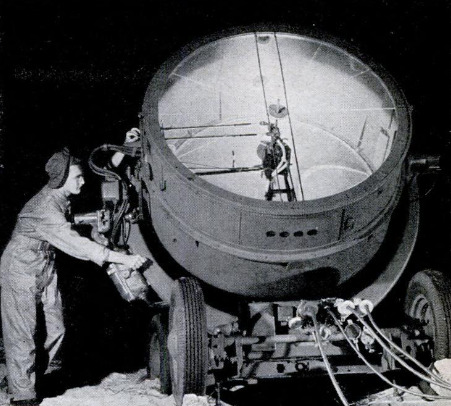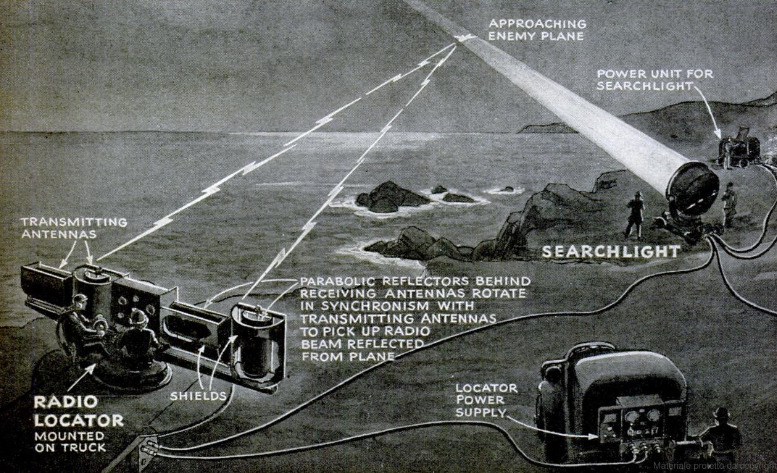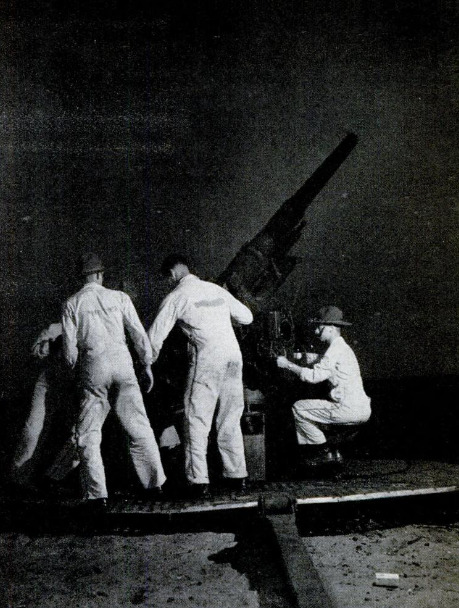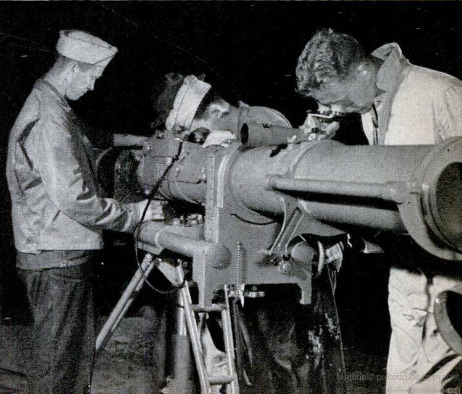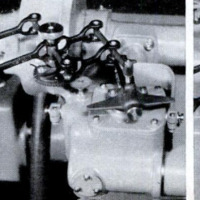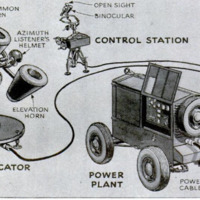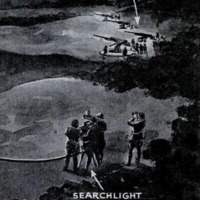-
Title (Dublin Core)
-
Night watchmen of the skies
-
Article Title and/or Image Caption (Dublin Core)
-
Night watchmen of the skies
-
extracted text (Extract Text)
-
Ingenious machines crews in air-raid protection
DARKNESS and silence cover the scene
—the Coast Artillery area guarding a
seaboard city—and the activities
of the day seem long since to have ended.
But in an isolated section, far away from
the big-gun emplacements and the barracks,
a small group of men are engaged in quiet,
intense work. They are the watchdogs of
the Army, members of an antiaircraft
searchlight unit, whose job is to detect,
track, and illuminate raiding enemy planes
and keep them illuminated while crews of
antiaircraft gun batteries blast them from
the skies.
It is an eerie job. A layman observer,
permitted to witness a night of practice,
sees long lines of cables snaking through
the sandgrass, leading from an instrument
that looks like a botanist's nightmare—a
cluster of weird, mechanical bell-shaped
flowers—to other devices that appear squat
and formless in the dark.
He sees helmeted men attach themselves
to the flower cluster by means of thumb-
thick tubes, like an insect’s antennae, which
are fastened to each helmet's ears and con-
nect with the center of the instrument. He
watches the men twist wheels which ele-
vate the flower-shaped horns or turn them
horizontally.
He learns that the snakelike cables are
transmitting electrical impulses which car-
ry information to one of the squat instru-
ments, 500 feet away, where other men
turn wheels and fasten their gaze on dials.
He hears the chief of section of the unit
give a brief command and suddenly, from
a thing that has been dark and dead,
perched atop a sand dune, shoots a blinding
beam of light—and in the center of that
beam, thousands of yards from the ground,
the murderous throb of a bomber’s motors
is transformed in an instant into a clearly
distinguished plane. The target has been
“flicked” dead center.
To “flick” so fast and elusive a target as
a plane demands a high degree of codrdina-
tion and an immense amount of practice.
The problem of the Army's watchdogs, in
its essentials, is to pick up the sound of an
enemy plane as far away as possible, de-
termine its position and direction, track it
as it approaches, and illuminate it at the
earliest possible moment 80 that the gun-
ners of the antiaircraft batteries will have
‘something to shoot at.
The first business in hand on this night
in the sand dunes is the botanist's night-
mare, the sound locator. In its newest de-
velopment this consists of three bell-shaped
horns attached to a metal column which
rests on a platform. The horns are designed
to act as huge extensions of the human ear.
The three horns form a triangle and the
middle horn is common to the other two.
That is, the middle horn is paired with the
bottom horn to obtain the elevation of a
plane, and with the top outside horn to
obtain azimuth, or the horizontal angle, and
thus establishes direction. The old-style
sound locator had four horns, two for eleva-
tion and two for azimuth, until it was dis-
covered that one horn could be made to
do the work of two.
Two helmeted men, their headsets at-
tached to tubes leading from the hearing
mechanism, face each other on the plat
form. One, who is the elevation listener,
turns a small handwheel and raises or low-
ers the horns until the thrum-thrum-thrum
of the plane's motors seems to be directly
in the center of his brain, neither stronger
toward the left ear nor stronger toward the
right. When he has centered the sound he
knows he has the horns set correctly to ob-
tain the elevation of the plane.
Similarly, the second man, who is the
azimuth listener, turns his handwheel and
moves the horns in a horizontal circle until
he, too, has centered the sound in his head
and knows that he is on the correct azi-
muth.
But there is one very important calcula-
tion still left out, which requires the pres-
ence of a third man, who is known as the
corrector operator. Since sound travels at
about 1,100 feet a second it is obvious that
when the hum of a plane's motors reaches
the locator, the plane has traveled a con-
siderable distance from the spot where the
horns would place it.
To correct this sound lag, a small device
known as a pantograph is a part of every
locator. The pantograph is geared to the
locator’s tracking mechanism. When the
corrector operator has centered the image
of a ball, which is on the end of the panto-
graph, between cross marks on a mirror, he
has automatically applied corrections for
sound lag, wind error, target speed, and
parallax error created by the distance
(ideally about 1,000 feet) between the sound
locator and the searchlight.
Just below the pantograph is another tiny
device, known as a course indicator. This
is in the shape of a miniature airplane and
is cobrdinated with the movement of the
horns to indicate the direction in which the
target is flying.
While the sound locator is an efficient in-
strument, the great speed of modern air-
craft makes its range too limited to be
completely satisfactory. The Army, there-
fore, is developing a new and secret device
about which no detailed information can be
given. This is a radio direction indicator,
based on the principle of similar devices
now being used by the British which are
said to be able to pick up an enemy plane
before it leaves the French coast and track
it across the English Channel. The range of
this radio locator is part of the Army's
secret, but it extends perhaps up to 100
miles.
Cables from the binaural sound locator
described above lead to ‘the searchlight and
thence to an apparatus called the control
station, which is operated by three men.
The control station, by which the light is
moved electrically, is situated at least 50
feet and perhaps as much as 600 feet away
from the light. This enables observers to
see more clearly, just as a man will hold a
lantern away from him in order to avoid
being blinded by its rays.
The corrected data flow from the sound
locator to the control station where there
are an azimuth tracker and an elevation
tracker. Here handwheels are turned until
the azimuth and elevation dials correspond
to the information that is constantly com-
ing in from the locator. The light moves
correspondingly as the wheels are turned and
at the moment when the plane is believed
to be within range the light is turned on.
The antiaircraft searchlights send out a
‘beam of 800 million candlepower intensity
produced by a carbon arc burning in a cra-
ter, the light being reflected by means of a
parabolic metal mirror. The beam has a
range of from 5,000 to 12,000 yards, depend-
ing on atmospheric conditions. The light
may be operated manually, but usually is
controlled from the control station.
One other piece of apparatus is necessary
to complete the set-up of one
searchlight unit. This is the
mobile power plant, which con-
sists of an air and water-cooled
gasoline engine driving an
electric generator that deliv
ers about 150 amperes and 78
volts to the searchlight. The
power plant is placed, if pos-
sible, with a knoll or some
other obstruction between it
and the other apparatus to
eliminate its sound.
Once the lights get on a tar-
get the anti aircraft-gun bat-
tery goes into action. Contrary
to popular impression, there is
no close association between a
searchlight battery and a gun
battery. The two work sep-
arately, each with its own in-
struments. When a target is
illuminated, the crew of the
gun battery track it by means
of a stereoscopic height finder
and director, by which azi-
muth and elevation readings
are obtained. Firing data are
electrically transmitted to the
guns and set by members of
the crew by turning hand
wheels. The fuse of the shell
is cut to explode at the desired
height, and the projectile
streaks skyward,
So ends a practice night
with the Army's watchdogs,
as they practice their job of
guarding our night skies.
-
Contributor (Dublin Core)
-
John Watson (article writer)
-
Language (Dublin Core)
-
Eng
-
Date Issued (Dublin Core)
-
1941-12
-
pages (Bibliographic Ontology)
-
52-57
-
Rights (Dublin Core)
-
Public domain
-
Archived by (Dublin Core)
-
Sami Akbiyik
 Popular Science Monthly, v. 139, n. 6, 1941
Popular Science Monthly, v. 139, n. 6, 1941


